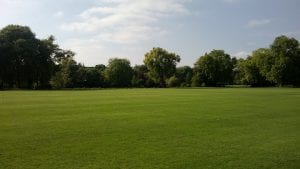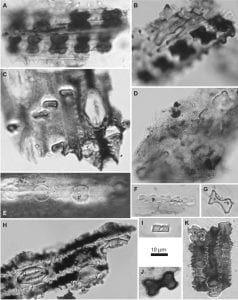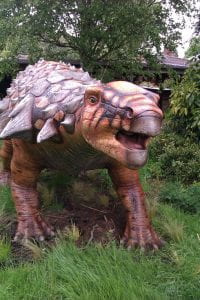How often do we as regular humans, living on this planet, think about grass? We don’t ever really. Grass is just there and, as far as most are concerned it always has been and always will be. But grass is a living organism, subject to all the same rules of life as everything else. Grass had to evolve which means, by definition, there was a time, a very long time, when it didn’t exist.

Placing an exact date on this monumental horticultural innovation has been a debate in palaeontology for as long as we’ve known about evolution enough to pose the question.
The first way to go about answering it is a simple one; we can look at the fossil record and see when we first find grass. When we’ve got a grass fossil, we know that is definitive proof that grass existed at that time. In palaeontology, we call this a “hard minimum”. We know that by this time in history, grass had evolved because, well, there it is.
For a long time, this date was placed at around the 50 million years ago mark. This produced the surprising and regularly quoted idea that no dinosaur would ever have seen even a single blade of grass, seeing as they’d all become extinct around 16 million years previously.
However, as much as can be solidly stated from a hard minimum, there are naturally a lot of problems with it too. A famous saying in science is that “Absence of evidence is not evidence of absence.” This just means that, simply because you can’t see a fossil there, doesn’t necessarily mean the organism wasn’t there at that time.
In 2005 this long-standing belief was turned completely around by a discovery in India dating back to the Late Cretaceous. By examining the coprolites (fossilised dung) of extinct animals, palaeontologists can get some idea of what foods they were eating. In the case of these fossils, while not easy to say for certain what kind of dinosaur the remains come from, what is clear is what they contained; grass.

More than this, it was a diverse assemblage of grass. The scientists were able to determine five different taxa of grass, suggesting that perhaps the plant group may already have been spreading for some time. Later finds would go on to discover that other families of grass, such as primitive rice plants, had also existed during the Cretaceous. For the first time we could be certain, not only did grass exist during the dinosaur age, but dinosaurs actively grazed on it too.
Fossils aren’t the only way of estimating the appearance of different groups however. Seeing as grasses have so many living representatives today, it allows scientists to examine their genetics. I won’t go into too many details here, partly to avoid things getting too technical, but mostly because it is FAR from my area of expertise and I truly don’t wish to put my foot in my mouth by saying something stupid and wrong my phylogeneticist colleagues will mock me for.
However, I will say that essentially by examining how the genomes of the living organisms differ from one another, combined with the knowledge of mutation rates, it is possible to estimate how long ago the species diverged from each other in their evolutionary past. Do this with enough members of the appropriate groups and it’s possible to get an approximate time of origin of the whole family. With any luck that explanation was the right balance of accurate enough without needlessly complicating the matter (I’m a classical palaeontologist, coding phylogeny analyses scares me).
Results of these kinds of analysis are mixed, with some evidence suggesting that the families of grass we know of today were only firmly established in around 55 million years ago, and any grass existing before then were primitive forms we wouldn’t recognise today. Other theories suggest that perhaps grass evolved at slower rates than we might expect, and that the initial major diversification took place as early as 82 million years ago, well within the Cretaceous period.
Evolving in the Mesozoic era means that grasses would have played a role in one of the major events of the time; we call it the Cretaceous Terrestrial Revolution (CTR). It wasn’t only grasses that appear at this time, as the fossil record also shows us the very first appearance of flowering plants. Again, it’s difficult to imagine a time without the splashes of colour that flowers provide the landscape, but the vast majority of dinosaurs were forced to live without them. But the CTR is quite a large and important topic, so not worth diving into here, lazily tacked on to a post about grass.

So, whilst the idea that dinosaurs never co-existed with grass isn’t accurate, it seems likely that it wasn’t nearly as diverse or prevalent for them as it is for us; only appearing late on in their reign, and not truly diversifying into its modern forms or claiming global dominance until after they disappeared.
As for the question of why I’ve dedicated an entire blog post to grass, like the crustaceans last week, it’s good to show that palaeontology isn’t all dinosaurs, and that palaeobotanists (and all of the less glamorised areas of the science) deserve to have their discoveries shouted about too! So now they’ve got Ellie Sattler and this blog post. It’s a start.
There’s also that time that I was on the Game Grumps Jurassic Make Off series when I stated that grasses didn’t exist in the dinosaur times, and then corrected myself seconds later to say that primitive grasses were there but it wouldn’t have been the same as the way we picture grasslands today, and then that bit got edited out so that all I said was the first (incorrect) statement… I’m in no way still bitter about this a year later and writing a blog post about it to set the record straight. That would be silly.
Rhys Charles is the Engagement Officer for the Earth Sciences department of the University of Bristol, and has headed the Bristol Dinosaur Project since 2016.
Article edited by Emily Green
References
Prasad, V. et al. (2005) Dinosaur coprolites and the early evolution of grasses and grazers. Science. 310: 1177 – 1180
Prasad, V. et al. (2011) Late Cretaceous origin of the rice tribe provides evidence for early diversification in Poaceae. Nature Communications. 2: 480
Christin, P. et al. (2014) Molecular dating, evolutionary rates, and the age of grasses. Systematic Biology. 63: 153 – 165

